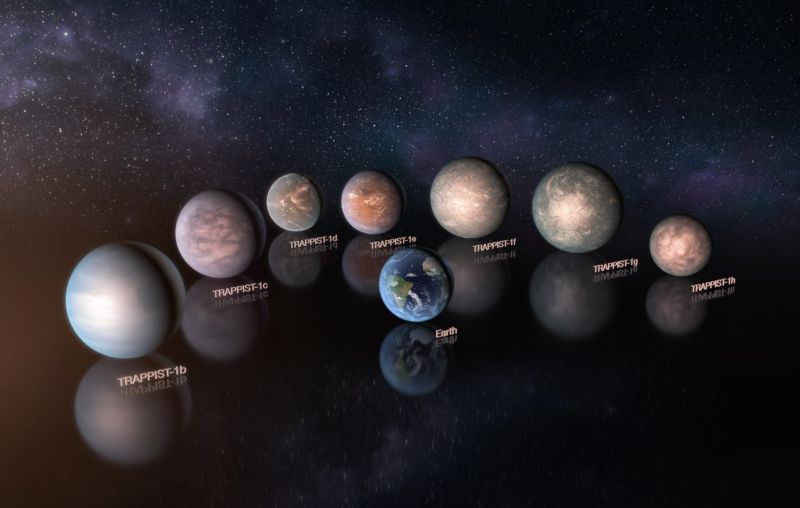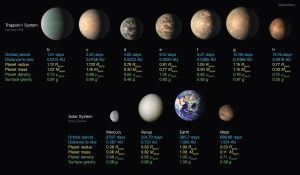
We've now developed a healthy-sized catalog of planets orbiting in the habitable zone of distant stars. But we don't have the slightest idea whether any of them are actually habitable. That's largely because, at these distances, it's extremely difficult to get any sense of what the planets are made of and what their atmospheres are like. And the greenhouse potential of the atmosphere can make the difference between a frozen world like Mars and an out-of-control hothouse like Venus.
But at least in the case of one nearby star, scientists are slowly narrowing down the options. TRAPPIST-1 has at least seven planets, all small enough to be Earth-like, with several inside the star's habitable zone. In two papers released this week, teams of scientists have narrowed down what their atmospheres might look like and provided a greater sense of their composition. The results suggest that at least one planet has the potential to be a watery world.
In the air
The first study, which appears in Nature Astronomy, looks at the atmospheres of several of the planets, but not directly. Instead, it relies on the Hubble to observe the star's light as a planet passes in front of it. A tiny fraction of the photons will have passed through the planet's atmosphere on their way to Earth. Any colors of light that are absorbed or scattered by the gases in the atmosphere will be missing from that fraction, making it possible to infer the atmosphere's composition.
It's possible, but not easy. In this case, the planets were observed as the Hubble Space Telescope orbited through something called the South Atlantic Anomaly, where the Earth's radiation belts dip to meet its orbit. Images taken during this time have more radiation-induced noise and lower resolution, as the telescope shuts down its fine-pointing hardware.
While the results don't tell us what's in the atmosphere, they do tell us what's not likely to be there: lots of hydrogen. The spectrum of the atmospheres of these planets is relatively featureless, whereas hydrogen would absorb at a number of different wavelengths covered by the Hubble data. It's possible to get something that looks like this if a lot of clouds are present, but there's no obvious way of generating the aerosols needed for clouds in a hydrogen rich atmosphere. Earlier work had reached this conclusion for the innermost planets; the new data excludes hydrogen for planets d, e, and f. That only leaves TRAPPIST-1 g for further study.
That doesn't tell us what's in these atmospheres. For many of the planets, a variety of compositions are consistent with the data. For b and c, for example, the authors say the options include "atmospheres dominated by water, nitrogen, or carbon dioxide; tenuous atmospheres composed of a variety of chemical species; and atmospheres dominated by aerosols." But ruling out hydrogen is significant for two reasons. One, it's likely that most planets start out with hydrogen-rich atmospheres, so this suggests these planets have evolved a bit. The second is that hydrogen is a potent greenhouse gas and, so, would have a strong influence on the planet's temperature.
On the ground
Separately, a team of researchers looked into the composition of the planets. This is done by a combination of observations. The transits of the planets, combined with their distance from the star, gives us a measure of their size. Given their mass, we can calculate their density, which tells us a lot about their likely composition.
Getting the mass normally involves watching how much each planet pulls the star around as it orbits. But that has not been possible with TRAPPIST-1, because the star's light is so faint. Instead, researchers have been looking at how much the planets pull on each other. This shows up in small variations in how long an orbit takes; sometimes a planet is pulled ahead by its neighbors, other times it is dragged back.
For two planets, using these changes to calculate the mass of a planet is simple physics. For a system with seven planets, the calculations get rather dramatically complex, and there can be multiple plausible solutions. To handle TRAPPIST-1, the authors put the planets' major properties into a single vector and ran the vector through a genetic algorithm that tested different permutations of the vector, then recombined the most successful. The result was an optimized solution that included the masses of all the planets.

The resulting masses were then used to infer the likely composition. TRAPPIST-1 c and e seem to be rocky bodies, but the remainder (b, d, f, g, and h) all seem to have some less dense components. These could be thick atmospheres, water, or an icy shell. This non-rocky portion of their mass is typically less than five percent—which may not seem like a lot but is far more than the Earth's oceans and atmosphere combined.
Combined with data on their position relative to the star, the authors conclude that the non-rocky material in b is almost certainly in the atmosphere—if it has any water, it's going to be in the form of water vapor, which would neatly explain its low density. Planet d is right near the limit for a runaway greenhouse, so it could easily have a similar water-rich atmosphere. Alternatively, d is one of the planets that is likely to be cooked by induction heating from the star's magnetic field, so the greenhouse gases may be unnecessary for boiling off its oceans.
Planets f, g, and h could all be ocean worlds or covered with icy shells, depending on the amount of greenhouse gases in their atmospheres.
So, while we don't yet have a complete picture of these planets, one is slowly coming into view, and the data put a bunch of constraints on how we interpret any further information we're going to obtain. Our next chance for big refinements, however, may have to wait on the launch of the James Webb Space Telescope, slated for next year.
Nature Astronomy, 2018. DOI: 10.1038/s41550-017-0374-z (About DOIs).
Astronomy & Astrophysics, 2018. DOI not yet available.
Bagikan Berita Ini














0 Response to "Planets of TRAPPIST-1: Complex atmospheres probably lots of water"
Post a Comment